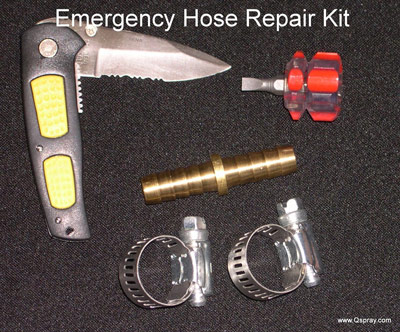Pest /Weed Control Equipment – Prevent Downtime
Spray equipment breakdowns can wreak havoc on your schedule, impact your customers and hurt company profitability. Yet with a little planning some downtime can be avoided.
Here is one simple tip. Keep easy-to-replace parts in each truck so that minor repairs can be completed in the field. A repair in the field allows technicians to avoid a trip across town to the repair shop and thus complete their scheduled stops without customer impact.
Pest/weed control equipment wears out. Parts need to be replaced. You will need to buy there parts anyway, you might as well have them when and where you need them. Here are some ideas for parts for your emergency repair kit:
Compressed Air Sprayers: Rubber parts swell or wear out with exposure to pesticides. (Note: some of the natural, botanical products are even tougher on rubber). Examples of parts to keep in your kit: check valve, lid gasket, tip, tip o-rings, etc.
Backpack Sprayers: spray tip, o-rings, filter, lid gasket, check valve, etc.
Power Sprayers:
Line Strainer/Filter: Your filter is the source of quite a bit of trouble, so this is probably the most important part of your emergency repair kit. Be sure to include the filter o-ring as well as the steel screen.
Spray Guns: Some commonly used pest control spray guns (e.g, Green Garde, Spraying Systems) will leak when o-rings swell. Many of these o-rings are easy to change out in the field. Eventually spray tips become clogged or wear out. Keep a replacement in your kit. Some guns are connected to spray hoses with garden hose fittings. These fittings use garden hose washers which are easily replaced.
Pumps: Some spray pumps use parts that can be easily replaced in the field. Dampner diaphragms are a common source of trouble on diaphragm pumps. A wrench can be used to gently tighten a leaking gear pump. An extra fuse can get a 12 volt pump or electric hose reel back in service in minutes.
Engine: Your gas engine uses a belt to drive the pump. Changing a bad belt is one of the easiest repairs you can make on your power spray rig.
Spray Hose: Your spray hose is dragged across rocks, building corners, trees, etc. This wear can cause downtime and spills that need to be cleaned up. You can create a temporary hose repair kit with a knife, screwdriver, 2 clamps and hose mender. These parts are available from your spray equipment provider. The repair will enable the technician to finish the day’s route and get back to the repair location where a more permanent repair can be effected.

Emergency Hose Repair Kit
A couple of caveats when creating your emergency repair kit:
– Focus on minor, easy to accomplish repairs that don’t require expensive tools
– Customize the emergency repair kit based on your equipment, technicians, experience, etc.
– Consider technician skill when deciding what types of repairs he or can perform (note: this falls under the rule, don’t send your ducks to eagle school). Be sure to train technicians when providing them with repair kits.
– Make sure technicians report what repairs they have made. When conducting truck inspections, check repair kits to see what parts are used. Track repairs to find problem areas. Modify repair kits based upon what you find.
A few dollars expended and a few moments spent training technicians to make field repairs will pay dividends well in excess of your cost. Your customers will benefit as will your bottom line.
PS – This article addresses Pest & Weed Control spray equipment but the Emergency Repair Kit principal applies to most every type of equipment.
Hope this helps. Comments appreciated.
